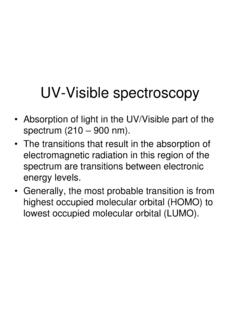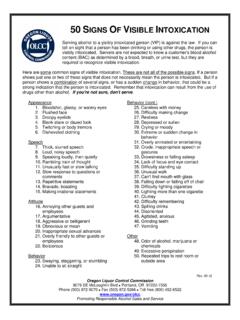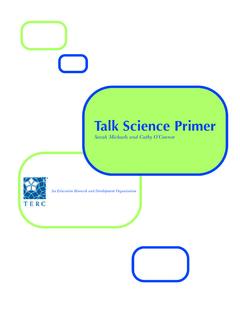Transcription of Visible Learning: The Five Strands - Midlothian
1 Visible Learning: The Five Strands John Hattie Midlothian Council Educational Psychology Service The Spotlight Visible Learning series includes an introduction to Visible Learning Visible Learning Series and Teaching'- the research of John Hattie (Spotlight 1), and outlines prominent Spotlight 2. topics arising from his research: Feedback for Learning' (Spotlight 3) and Mindframes for Teachers' (Spotlight 4). This paper aims to provide an overview October 2014. of the five Strands ' of a Visible learning school as described by Hattie. "They know enough to What does Visible Learning mean?
2 Know how to learn." (Henry Adams). Visible Learning means an enhanced role for teachers as they become evaluators of their own teaching. Visible Teaching and Learning occurs when teachers see learning through the eyes of students and help them become their own teachers' (Hattie, 2014). What does Visible Learning look like? The Five Strands 2. Know Thy Impact! 3. Inspired and 4. Effective What teachers do Passionate Teachers Feedback matters! How teachers think matters! How can we give Teachers should be feedback that has evaluators of their own the biggest impact teaching on student learning?
3 5. Visible Learning Schools Learners What are the major factors that influence How can we build student achievement? assessment capable What strategies and systems do we have in learners? our school to implement Visible learning? Being assessment- capable is having the skills to assess your own 1. Visible Learners learning The first key message of Hattie's research is to ensure that our students are assessment-capable learners and that this is the most important thing that we can do to raise student achievement. Visible learners have high expectations of their learning and are not afraid to ask questions or make mistakes; Visible learners are guided to self-regulate their learning.
4 Hattie suggests that the learning aim of any set of lessons is to get students to learn the skills of teaching themselves the content and under- standing' (Hattie, 2012). This requires explicitly teaching students important meta-cognitive skills and strategies; therefore, time spent learning about the learning process and developing a shared language of learning is considered essential in establishing students' ownership of their learning and the ability to drive their learning forward. Page 2 Visible Learning: The Five Strands 2. Know Thy Impact! 4. Effective Feedback What we do doesn't matter nearly as much as how Hattie's research shows that feedback is one of the most powerful kids experience what we do' (from It's not what we factors influencing learning with an effect size of However, teach: It's what they learn' Kohn, Education Week the effect of feedback was also found to be one of the most 2008).
5 Variable and there is often a mismatch between how teachers and students experience feedback. It therefore follows that the primary role of a teacher is to evaluate their effect on learning. There is a strong Feedback aims to reduce the gap' between where the student is mindset in the Visible learning research on the and where they are meant to be. For effective feedback teachers evaluation of our impact where the fundamental must have a good knowledge of these two positions and they reason for administering assessments in the classroom must be able to make this gap' Visible to the student.
6 Students is to find out what you as the teacher did well who need different types of feedback throughout their learning did you teach well and who not so well, and so on. On process. Hattie identifies three questions which effective feedback the basis of this, teaching is about becoming an should address: adaptive expert', seeing yourself as an evaluator who is able to see learning through the eyes of the Where am I going? Feed up student', using the evidence to inform actions, allowing teaching to be flexible and adaptive to advance How am I going? Feed back learning. Where to next?
7 Feed forward Hattie (2012) highlights the importance of how feedback is received not just the feedback we give and how teachers seek feedback from students. Students want feedback just for them, just in time, and just and Passionate Teachers helping nudge forward. So worry more about how students are receiving your feedback much more than increasing how much Inspired and passionate teachers are evaluators who collect you give'. evidence about their success as change agents, about their Feedback vs. Praise levels of inspiration, and about sharing their passion with students' (Hattie, 2014).
8 Do not confuse feedback with praise! Feedback is not about approval it's about finding out about where to go next. Researchers acknowledge that it may be more appropriate In learning it is better to increase informational feedback and go lean to talk about inspired teaching' rather than inspired teachers on praise. as we can be inspired most days but not necessarily all days. The mindframes that underpin the Visible learning approach are detailed in Spotlight 4: Mindframes for Teachers' and can 5. Visible Learning Schools be considered to be the characteristics of inspired and passionate teaching.
9 They are: Within the wider school context, there are a number of factors which contribute to a Visible Learning School. The climate of the I am an evaluator I engage in dialogue not school should be one of trust, respect and integrity. An ideal classroom and staffroom celebrate effort and progress, are monologue I am a change dominated by dialogue (rather than monologue!), with a balance agent I enjoy the challenge of talking, listening and doing for all individuals. School leaders have a central role in building school ethos and on focusing on I talk about I develop positive the quality and impact of teaching in the school.
10 Learning not about relationships teaching I inform all about the I see assessment as language of learning There is no prescribed set of steps to becoming a feedback to me Visible Learning school, it is a process of self - evaluation of the five Strands . Schools can determine which areas to develop and which key outcomes to Steele (2009) considers that we all recall our favourite teachers because they cared deeply that we shared their evaluate by gathering evidence and working passion and interest in their subject, they seemed to take collaboratively to identify where they are and extra effort to make sure that we understood; they had the planning where they want to be.




